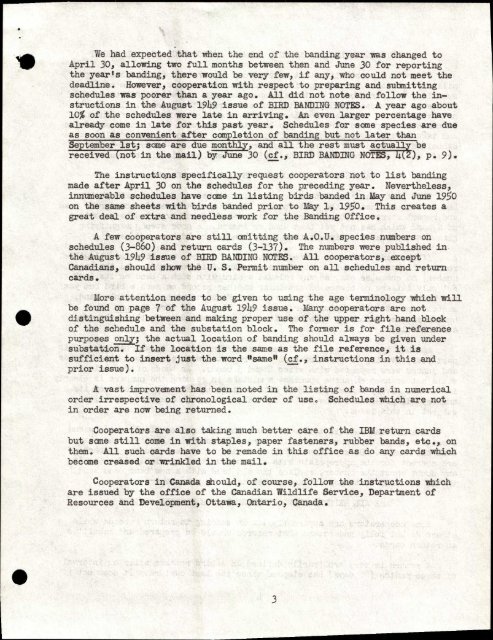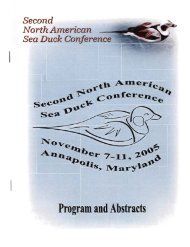BIRD BANDING NOTES - Patuxent Wildlife Research Center
BIRD BANDING NOTES - Patuxent Wildlife Research Center
BIRD BANDING NOTES - Patuxent Wildlife Research Center
You also want an ePaper? Increase the reach of your titles
YUMPU automatically turns print PDFs into web optimized ePapers that Google loves.
We had expected that when the end of the banding year was changed to<br />
April 30, allowing two full months between then and June 30 for reporting<br />
the year's banding, there would be very few, if any, who could not meet the<br />
deadline. However, cooperation with respect to preparing and submitting<br />
schedules was poorer than a year ago. All did not note and follow the instructions<br />
in the August 1949 issue of <strong>BIRD</strong> <strong>BANDING</strong> <strong>NOTES</strong>. A year ago about<br />
10% of the schedules were late in arriving. An even larger percentage have<br />
already come in late for this past year. Schedules for some species are due<br />
as soon as convenient after completion of banding but not later than<br />
September 1st; some are due monthly, and all the rest must actually be<br />
received (not in the mail) by June 30 (cf., <strong>BIRD</strong> <strong>BANDING</strong> <strong>NOTES</strong>, 4( 2 ), P. 9).<br />
The instructions specifically request cooperators not to list banding<br />
made after April 30 on the schedules for the preceding year. Nevertheless,<br />
innumerable schedules have come in listing birds banded in May and June 1950<br />
on the same sheets with birds banded prior to May 1, 1950. This creates a<br />
great deal of extra and needless work for the Banding Office.<br />
A few cooperators are still omitting the A.O.U. species numbers on<br />
schedules (3-860) and return cards (3-137). The numbers were published in<br />
the August 1949 issue of <strong>BIRD</strong> <strong>BANDING</strong> <strong>NOTES</strong>. All cooperators, except<br />
Canadians, should show the U. S. Permit number on all schedules and return<br />
cards.<br />
More attention needs to be given to using the age terminology which will<br />
be found on page 7 of the August 1949 issue. Many cooperators are not<br />
distinguishing between and making proper use of the upper right hand block<br />
of the schedule and the substation block. The former is for file reference<br />
purposes only; the actual location of banding should always be given under<br />
substation. If the location is the same as the file reference, it is<br />
sufficient to insert just the word usameo (cf., instructions in this and<br />
prior issue).<br />
A vast improvement has been noted in the listing of bands in numerical<br />
order irrespective of chronological order of use. Schedules which are not<br />
in order are now being returned.<br />
Cooperators are also taking much better care of the IBM return cards<br />
but some still come in with staples, paper fasteners, rubber bands, etc., on<br />
them. All such cards have to be remade in this office as do any cards which<br />
become creased or wrinkled in the mail.<br />
Cooperators in Canada should, of course, follow the instructions which<br />
are issued by the office of the Canadian <strong>Wildlife</strong> Service, Department of<br />
Resources and Development, Ottawa, Ontario, Canada.












